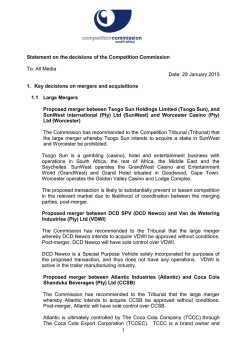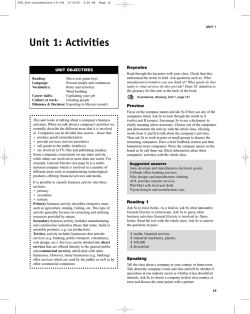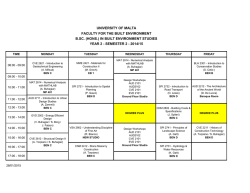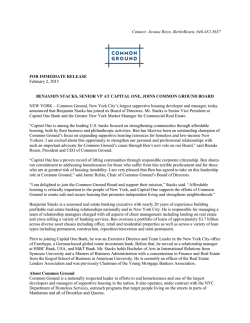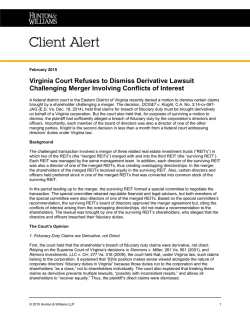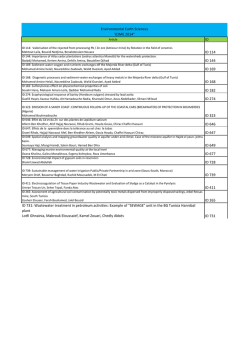
Unit 1: Alliances
•INT_Upper_15-43 4/5/06 12:49 PM Page 15 UNIT 1 Unit 1: Alliances UNIT OBJECTIVES Reading: Language: Vocabulary: Career skills: Culture at work: Dilemma & Decision: Spring in their steps Review of tenses Definitions; metaphors Building relationships Working relationships Breaking the ice (memo) This unit focuses on different types of alliances and looks at the advantages (e.g. a merger can provide fast growth and diversify a company’s investment portfolio) and disadvantages (e.g. there can be clashes of cultures). Merger: two or more companies join together to create a single larger company. Takeover: similar to a merger with one company taking control by buying more than half the shares. Joint venture: two or more companies make a joint investment in a project without actually merging. Partnership: two people or businesses who work together. The Dilemma & Decision section on page 14 focuses on the merger between Unilever, the consumer products company, and Ben & Jerry’s, the ice cream company – companies with different cultures. Keynotes Ask Ss to look at the title on page 7 ‘Company bosses on the prowl’. What do they think the title means in relation to the topic of the unit? Elicit that ‘prowl’ means to move carefully and deliberately after one’s prey, for example, when hunting. Then ask Ss to look at the picture. Ask questions such as: What does the picture show? Who / what does the man in the foreground represent? the group in the background? The picture shows a man riding a lion stalking his prey – a group of people riding a variety of animals. The scene represents a company boss preparing to pounce on weaker companies, as potential takeover targets. Ask Ss to read the keynotes and check they understand the terms in bold. You may wish to elicit other forms of some of the words, e.g. to merge / merger, to acquire / acquisition, to take over / takeover, strategy / strategic, to bid / bid. Draw Ss’ attention to the glossary for this unit at the back of the book. Coursebook, Glossary, Unit 1, page 147 Optional activity You may wish to ask Ss to discuss in pairs the difference in meaning between similar words, e.g. merger, joint venture, takeover, acquisition, alliance. Encourage Ss to use their dictionaries to help them. Then ask Ss to work with another pair. Each pair takes it in turns to define one of the words. The other pair has to guess which word is being described. Preview As a lead-in, ask Ss what they know about the six companies. What do they make / do? Ask Ss to work in pairs. Ss match the companies they think have formed a strategic alliance. Disney–Miramax Starbucks–Pepsico Chrysler–Daimler Benz Listening 1 1 Ask Ss to listen and check their answers. Listening 1 2 Ask Ss to listen again and answer the questions. 1 Starbucks wanted to get into bottled drinks; Pepsico wanted to create an innovative product. Chrysler and Daimler both felt they couldn’t face the competition in the automotive industry alone. Miramax needed money; Disney liked the serious image of Miramax. 2 Starbucks–Pepsico succeeded because the merger gave both of them something that they wanted. Daimler–Chrysler succeeded in the end, despite their different corporate cultures, because they worked hard to sort out their differences and problems. 3 Disney–Miramax failed because they were very different and couldn’t find anything in common. Reading 1 As a lead-in, draw Ss’ attention to the title of the article on page 9. What do they expect it to be about? Then ask Ss to scan the article quickly to look for confirmation of their predictions. 15 •INT_Upper_15-43 4/5/06 12:49 PM Page 16 INTELLIGENT BUSINESS (UPPER INTERMEDIATE) TEACHER’S BOOK: COURSEBOOK Then ask Ss to reread the text quickly and decide if the author is optimistic or pessimistic about strategic alliances. optimistic (but advising caution) Reading 2 Ask Ss to read the text again more carefully and decide which of the six statements are true or false. Refer Ss to the glossary box at the top of the page and remind them of the glossary for Unit 1 at the back of the book. 1 false (… they are once again on the prowl.) 2 true 3 false (… the idea of the conglomerate … with a diverse portfolio of businesses, went out of fashion …) 4 false (… regularly proves the ruin of many big media takeovers.) 5 false (… CEOs will be judged less for spotting a good target than for digesting it well …) 6 true Reading 3 Ask Ss to read the text again and answer the questions. 1 They slowed down for a while because of the dot-com boom. 2 The figures are heavily influenced by the time period chosen and, in any case, one out of four is quite a good ratio when compared with the chances of getting a new business started. 3 They should be clear about what they are going to do with the business they acquire. They shouldn’t be overconfident about their abilities. They should be aware that they will be influenced by the herd instinct, the feeling that it is better to be wrong in large numbers than to be right alone. Speaking Ask Ss to work in pairs / small groups and discuss the questions. Encourage Ss to give reasons for their views. You may wish to ask follow-up questions, such as: Can you think of any recent mergers that have taken place? Were they succcessful? Why / Why not? Why did the companies find it difficult to make their mergers work? 16 Optional activity Put Ss into pairs. Prepare a set of vocabulary cards (each card should have a word or phrase from the Unit 1 glossary on page 147 on it). Give each pair a set of cards face down. Ss take it in turns to pick a card and describe the word / phrase on it to their partner who guesses what the word / phrase is. Vocabulary 1 Ask Ss to match the words with their definitions. In feedback you may wish to ask Ss to make sentences using the terms (e.g. I am trying to expand my portfolio to include blue chip company shares.). 1f 2e 3a 4c 5b 6d Vocabulary 2 Check Ss understand what a metaphor is (a way of describing something by referring to it as something different, and suggesting that it has similar qualities). Ask Ss why they think the author uses hunting and animal metaphors. Then ask Ss to find metaphors in the text on page 9 to match the definitions given. Suggested answer The author probably uses hunting and animal metaphors to grab the attention of his / her readers. 1 hibernation 2 (animal) spirits 3 target (they might attack) 4 predator Practice As a lead-in, ask Ss questions such as Why do you think companies engage in mergers, etc.? Tell Ss they are going to read a short article about why companies merge and what can go wrong. Ask Ss to read the text and complete the gaps using the words given. 2 portfolios 4 targets 6 fortunes 8 failure 3 acquire 5 chances 7 shareholder value •INT_Upper_15-43 4/5/06 12:49 PM Page 17 UNIT 1 Optional activity Optional activity As a lead-in to the Language check tasks, write some sentences on the board using different tenses, and the names of the tenses. Ask Ss to work in pairs and match each sentence with one of the tenses. Then ask Ss to discuss how to form each of the tenses. Refer Ss to the Grammar reference for Unit 1 on page 157 to check their answers. Language check 1 Ask Ss to read the example sentences and match each sentence to one of the five uses. 1b 2e 3a 4d 5c Language check 2 Ask Ss to name the tense used in each example. a present continuous c past perfect e future (passive) b present perfect d present simple Put Ss into pairs. Ask Ss to match the pairs of time markers with the tenses. 2 future (passive) 4 present simple Coursebook, Grammar reference, Review of tenses, page 157 Practice Ask Ss to complete the gaps in the article using the correct form of the verbs in brackets. Ask Ss to compare their answers in pairs. 2 has been 4 will become 6 has made 8 are becoming 10 will see Workbook, page 6 Listening 2 1 Tell Ss they are going to listen to someone talking about a company’s recent history. Ask Ss to listen to Joan Woolley and put the events in order, earliest first. 1e 2b 3g 4d 5f 6c 7a Listening 2 2 Ask Ss to listen again and answer the questions. (They need only listen to as far as ‘… it was still quite a shock.’) Language check 3 1 past perfect 3 present perfect 5 present continuous Ss work in small groups. Put time phrases (e.g. recently, at times like these) on cards. Put a set of cards face down in front of each group. Ss take turns in their group to take a card and make a sentence using the word or phrase on the card. Encourage Ss to make sentences about their company or other companies they know, e.g. By 2001 my company had taken over two other companies. After each S has made their sentences the other Ss in the group should confirm whether it is grammatically correct. 3 5 7 9 (has) accepted had not wanted / didn’t want do not get will cost 1 present perfect 2 past perfect 3 past simple Listening 2 3 Ask Ss to listen to Part 2 and list the four reasons Joan gives for why the merger failed. Which reason contributed most to the failure of the alliance? 1 different approaches to sales and marketing 2 very different products 3 different methods of team-working 4 didn’t manage to build relationships Not building relationships contributed most to the failure of the alliance. Speaking Put Ss into pairs. Ask Ss to discuss the three points. Then ask each pair to work with another pair and tell each other their views. In feedback you may wish to ask further questions, such as What is your experience of being taken over? What problems were there? What measures were taken by the companies to ensure a smooth transition? You might also want to brainstorm as a whole group different ways of easing transition (e.g. team-building activities, advisory groups comprising employees from both companies). 17 •INT_Upper_15-43 4/5/06 12:49 PM Page 18 INTELLIGENT BUSINESS (UPPER INTERMEDIATE) TEACHER’S BOOK: COURSEBOOK Writing Listening 3 Ss are going to write a short press release to publicise the fact that the company has won the award. This should include a brief history of the company based on the answers to Listening 2. (You may wish to ask Ss to prepare their press release in class, complete it for homework and then compare their answer with a partner in the next lesson before handing it in to be marked.) Tell Ss they are going to hear two people networking. Ask Ss to listen and answer the questions. Style guide, page 30 1 video games; metal pipes 2 They are both involved in China; they are both considering working with Culture Plus. 3 They could get a group (discounted) rate from Culture Plus. Teacher’s Book, Unit 11, Writing focus: Press releases, page 78 Optional activity Career skills 1 As a lead-in, ask Ss about their relationship with people they work with, their clients, suppliers, etc. Also ask them how important they think good relationships are in business. Then ask Ss to read the Career skills information and phrases. You may wish to promote discussion by asking Ss questions such as How important is exchanging cards in your culture / other cultures you know? How do you like to be addressed by others? How do your clients like to be addressed? Ask Ss to look at the tips. Elicit further tips to add to the list and write them on the board. Suggested answer Introduce people to others who may be of interest to them. Career skills 2 Ask Ss to match the phrases and the tips. Can they think of any other useful phrases that could go with each tip? 1d 2f 3a 4b 5e Workbook, page 7 Speaking Ask Ss to work in pairs (if possible, Ss should work with someone they do not know very well). Ask Ss to introduce themselves and find three things they have in common (e.g. relating to hobbies, work, families, holidays). Then ask Ss to tell the rest of the class what they found out about their partner. So that Ss have an opportunity to practise using the full range of phrases in the Career skills box, you may wish to ask Ss to carry out this task as a role-play, e.g., imagining they are meeting at a conference for the first time. Encourage Ss to introduce themselves, ask each other questions, show interest, set up a future meeting, etc. 18 Ask Ss to work in small groups and to come up with a list of Dos and Don’ts of interviewing potential business partners. Elicit the Dos and Don’ts and write up the points on the board. Then, as a whole group, Ss discuss which are the three most important pieces of advice from the whole list. Speaking Put Ss into pairs. Ask Ss to read the extracts and discuss why the people failed to build a relationship. What tips would they give them? Then ask Ss to improve what B says in each extract. Ss should then continue the conversation as a roleplay. Refer Ss to the phrases in the Career skills section. Suggested answers 1 B Oh, that’s interesting. I don’t think my company is in the best position to be featured at the moment, but please contact me again nearer the time. Here’s my card. A Great. I’ll give you a call … 2 B Yes, of course, but only for a short time as I have to leave soon. A Oh, thanks, that’s really kind … 3 B Not really – but I’m very pleased to meet you and I’d love to hear about your company. A Well, we’re in IT, and we mainly work with companies to … •INT_Upper_15-43 4/5/06 12:49 PM Page 19 UNIT 1 Culture at work Ask Ss to read the information about working relationships and then discuss the questions in small groups. Encourage Ss to give examples from their own experience, e.g. what have they experienced in multicultural settings such as negotiations and meetings? You may find it helpful to look at the Culture at work table from page 8 of the Skills Book; this is reproduced below. You may also find it useful to refer to the relevant section on Culture at work in the teacher’s notes supporting the Skills Book. People from specific cultures … People from diffuse cultures … seem friendly and accessible because they give information freely about themselves from the very first meeting. seem hard to know because they don’t tell you much about themselves unless they know you well. have friendly relationships with a lot of people who are not necessarily close or lifetime friends. These relationships may seem superficial to people from diffuse cultures. have a few close friends, with whom they have a long-term relationship and share many aspects of their private lives. are happy to talk about personal matters with anyone they meet. don’t like to talk about personal matters in the context of a business relationship. Task 1: Ss work in groups. Ask Ss to read the profiles and make a list of the similarities between the people involved and their companies (e.g. engaged in funding charitable activities). Task 2: Ask Ss to note down five things Niall FitzGerald could say to Ben and Jerry and the responses they might give (e.g. Your foundation sounds really interesting, I’d love to hear more / Well, we donate 7.5% of pre-tax profits to nonprofit organisations.). Refer Ss back to the Career skills box for useful phrases. Task 3: Ask Ss to discuss the questions. In feedback encourage Ss to give reasons for their views (e.g. they might want a guarantee that at least 7.5% of pre-tax profits continues to go to charity – We may not be able to offer 7.5% but I’m sure we can come to a figure that we’re all happy with.). Decision Ask Ss to look at the article on page 145 about the merger between Ben & Jerry’s and Unilever. What did each party say? You may wish to suggest to Ss that they browse the internet to find out what has happened since the merger. Write it up Skills Book, Culture at work, page 8 Teacher’s Book, page 117 Optional activity Ask Ss about their experience of ‘small talk’ with businesspeople from other countries. What did they find easy / difficult about engaging in small talk? What topics were acceptable with which nationalities? Dilemma Tell Ss they are going to read about Unilever and Ben & Jerry’s. Ask them what they may already know about the companies, e.g. what each produces. Give Ss a few minutes to read the brief. Ss are going to write a memo to staff about the decision to merge and why the decision was made. You may wish to ask Ss to prepare their memo in class, complete it for homework and then compare their answer with a partner in the next lesson before handing it in to be marked. Give each S a photocopy of the Writing preparation framework from page 188; then use the Writing focus (Writing focus: Memos) on the next page to link the use of the framework and the Style guide as Ss plan their writing. Encourage Ss to use different phrases for giving reasons for the decision. You may also wish to use the Writing feedback framework from page 189 to structure your feedback to each S. Optional activity Put Ss into pairs. Ask Ss to interview each other about their use of English using questions such as those below. Then ask Ss to tell the whole group what they found out. How often do you need to use English? Who with? What for? What do you find easy / difficult about learning English? How long have you been learning English? How do you think you need to improve your English? 19 •INT_Upper_15-43 4/5/06 12:49 PM Page 20 INTELLIGENT BUSINESS (UPPER INTERMEDIATE) TEACHER’S BOOK: COURSEBOOK Writing focus: Memos 1 First decide who you are. (In this case, Ss are Niall FitzGerald, CEO of Unilever.) 2 Every time you start to write, you need to ask yourself two questions: a What is the purpose of this piece of writing? b Who am I writing to? (Here Ss are writing to staff to inform them of the merger – and to explain why – with Ben & Jerry’s.) 3 Look at the section on Memos on page 24 of the Style guide. Notice the suggested structure of a memo: Date / To / From / Subject Introduction Main points Conclusion and recommendation Initials of the writer Is this structure appropriate for this memo? What are you going to put in the subject line? Plan the sections you are going to divide your memo into. Then note down the points you might cover in each section. 4 What style should the memo be written in? (As it says in the Style guide, memos tend to be less formal than business letters. They are usually short and clear, but not bossy. The language is simple and the tone is normally neutral.) 5 What phrases might be appropriate in your memo? (See the Style guide, particularly the phrases for giving information on page 24. Examples of useful phrases are underlined in the suggested answer opposite.) 6 Now go ahead and write the memo. 7 When you have finished, check your writing for: logical structure, clarity of ideas, accuracy of language, appropriateness of style. Style guide, Memos, page 24 Style guide, General rules, page 3 Style guide, Organising your writing, page 4 Skills Book, Writing 3, Memos, page 46 Teacher’s Book, page 151 Teacher’s Book, Writing preparation framework, page 188 Teacher’s Book, Writing feedback framework, page 189 20 Memo: Suggested answer (165 words) To: All staff From: Niall FitzGerald Date: 21 June Subject: Merger I am delighted to inform you that Unilever is to merge with Ben & Jerry’s, the well-known ice cream maker. You will no doubt be aware of recent reports in the media claiming, among other things, that Unilever’s main goal, as a successful multinational, to make a profit would be incompatible with Ben & Jerry’s ethical business practices and creative management. However, we are happy to be able to announce that a recent series of detailed talks between Unilever and Ben & Jerry’s has shown both companies that we have much in common. We have therefore decided to build on our shared commitment to social responsibility – we believe that this move will not only help us to diversify our portfolio of products, but will also enable the community to profit further from our joint business success. We will be holding meetings for all staff over the coming week, to outline the forthcoming merger process. In the meantime, if you have any questions, please contact Miles Junior on ext 394. NF
© Copyright 2025
